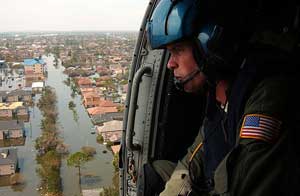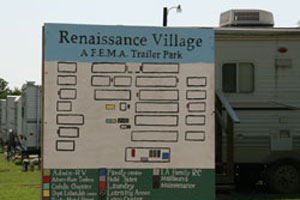
Photo: Wikimedia Commons
This story first appeared on the ProPublica website. It was co-published with the New York Times.
Three years before Hurricane Katrina inundated New Orleans, a senior executive at Pendleton Memorial Methodist Hospital assessed its vulnerability to the sort of flooding that had been long feared there.
His conclusion is now evidence in a lawsuit against Methodist that could have significant implications for hospitals nationwide.
“The first question is, do we have generators placed to accommodate an emergency flood with 15 feet of water?” wrote Cameron B. Barr, then an executive vice president.” The answer to that question is no. “One of the two main generators was located on a roof, he said, but another “would be nonfunctional at about two feet of flood water around the generator.”
Not only would it have to be relocated, he said, but the power plant and an underground tunnel connecting the plant to the hospital would have to be protected.
As a “back of the envelope” estimate, Mr. Barr wrote, “to protect the Hospital, East Tower, power plant building and to relocate the emergency generators and fuel supply would probably be a $7.5 million project.”
But the money was never spent, the power went out, and the hospital’s life-support machines stopped working. Now, the family of Althea LaCoste, a 73-year-old patient who died in what her family’s lawyers allege was sweltering heat after nurses spent hours pumping air into her lungs by hand in the pitch dark, is raising a potentially far-reaching legal question: How prepared do hospitals have to be for the worst possible circumstances?
More than 100 deaths occurred in New Orleans-area hospitals and nursing homes after Hurricane Katrina when emergency backup power systems failed and patients languished for days awaiting transport. About 200 lawsuits have been filed in Louisiana alleging that these institutions are liable for the deaths and for the suffering of other patients who survived because corporate failure to plan adequately for flooding and implement evacuation constituted negligence or medical malpractice.
The LaCoste trial is set to begin on Monday. “This could be a new theory of liability against health care institutions—lack of emergency preparedness,” said Kristin McMahon, an attorney and chief claims officer for IronHealth, a company that insures hospitals. “The courts across the country will be looking at it.”
The case has already been precedent-setting in Louisiana. The state’s Supreme Court decided the allegations were based on general negligence claims, as opposed to medical malpractice in which damages would be capped at $500,000. This markedly increased hospital owners’ potential liability.
Mrs. LaCoste’s family alleges that the hospital was negligent for having inadequate emergency power systems, evacuation plans and floodwater protection. They say a fuel pump that failed after it was flooded caused the higher generator to shut down—an event they say could have been avoided if the hospital had invested less than $10,000 in a submersible pump.
The hospital’s owners argue in court filings that Hurricane Katrina was an “act of God” that could not be foreseen, that the hospital was not negligent, and that it would be unreasonable to expect a hospital to be impervious to all of the unlikely catastrophes its emergency plans contemplate, including tornadoes and a “terrorist event.”
Methodist’s owners also maintain that the hospital’s emergency power system “met or exceeded applicable electrical codes and standards.”
But systems that meet those standards are “not always sufficient” in major catastrophes, according to a warning issued after Katrina by the organization that accredits most American hospitals, the Joint Commission. National electrical standards for hospitals were traditionally oriented toward maintaining electricity during common, brief local power outages, not prolonged emergencies.
National Fire Protection Association standards call for “careful consideration” to be given to protecting electrical components from “natural forces common to the area” such as storms, floods and earthquakes, but that guidance is not specific. Emergency systems do not have to be designed to power air-conditioning or heating. Other aspects of hospital emergency planning are even less regulated.
These problems were recognized years before Katrina. When Tropical Storm Allison flooded Houston in June 2001, some hospitals in the nation’s largest medical complex, Texas Medical Center, lost power because either emergency generators or their associated electrical components were located below flood level.
The assessment by the former Methodist hospital executive was made in response to an inquiry from Dr. Kevin Stephens, the New Orleans health director, the year after Tropical Storm Allison. Dr. Stephens asked whether generators at each hospital in the city could withstand a flood, how much it would cost to elevate them, and whether there was interest in having the city look into the issue. “They said it would cost millions of dollars,” he said. “And nobody had the money. They thought I was crazy.”
Across the country, the vulnerability remains. “There are many places that still know they have to move their generator,” said Robert Wise, a vice president of the Joint Commission. Without power, he said, hospitals are “literally dead in the water. It’s a critical asset.”
But most hospitals are juggling multiple priorities and operating on thin margins. Raising generators is not mandatory for hospital accreditation, and government agencies have rarely provided funding for the expensive work prior to a disaster. “This is a zero-sum game now,” Dr. Wise said. “Who decides it’s not important to buy critical machines for the intensive care unit or the operating room versus moving the emergency electrical system?”
A jury in New Orleans might have an answer.
Correction: In accordance with information in court filings submitted by hospital attorneys, this post originally identified Cameron B. Barr as a woman. Cameron B. Barr is in fact a man.












